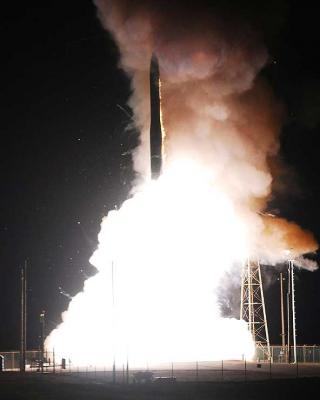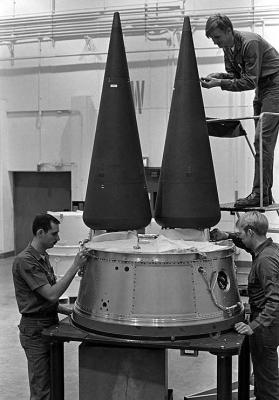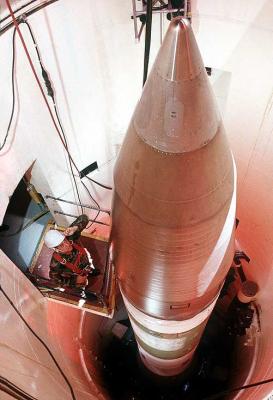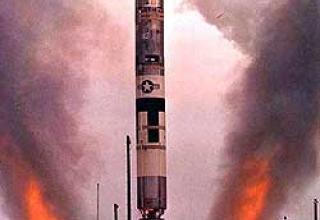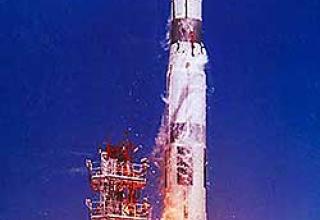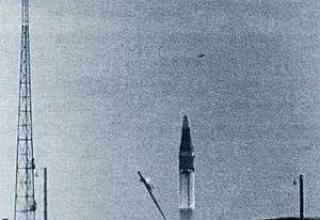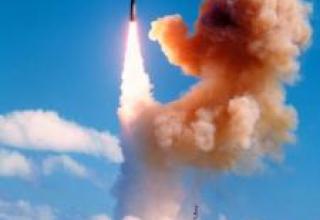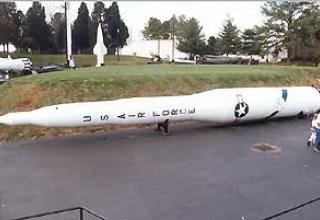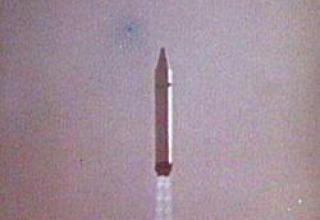The decision to create a new ballistic missile designated LGM-30G "Minuteman-3" was made in July 1965, when the U.S. Air Force Headquarters signed the first contract with the U.S. Air Force Corporation "Boeing" for research and development of a promising missile, which is a further development of the ICBM "Minuteman-2" and significantly unified with the latter in order to reduce costs and time required for development. In April 1966 the first contract was signed by Boeing Corporation for research and development of Minuteman-2. The Air Force General Staff issued System Management Directive SMD 6-61-133B(10), defining the requirements for the new weapon system. The main requirements included: an improved control system, increased range and weight-to-weight, increased resistance of the system to foammable substances, a new system of anti-missile defense means (AMS), and equipment of a separable head unit with thermonuclear warheads for individual guidance (RPGH IN). Subcontractors of the contract were firms: "Thiokol" - working out of the first march step; "Aerojet General" - working out of the second march step; "Thiokol" together with "Aerojet General" - working out of the third march step (later the basic contractor for the given step became branch "Chemical Systems Division" (CSD) of corporation "United Technologies Corp."). (UTC)); "Rocketdyne" - development of liquid stage of breeding; "Autonetics" - development of control system and BCVM on the element base of development and production of "Texas Instruments"; "General Electric" - development of head fairing, combat unit (BC) of new generation, KSP PRO, general integration of systems of RGCH IN. The combat unit was traditionally developed, tested and manufactured by the laboratories and plants of the Atomic Energy Commission. Already in July 1966, the combat unit designated Mk12 was first tested when launching the Minuteman-2 ICBM from the range at Cape Kennedy (Patrick Air Force Base, Florida).
Initially, the deployment of new ICBMs was supposed to be performed in the existing OS SLBMs built for early modifications of the Minuteman complex with further development of new basing options ensuring increased survivability. One such option was the Hard Rock Silo Program (building ICBMs in solid rock), first announced by Defense Minister R. McNamara in October 1967. Specific consideration of all the details of the program began in June 1968, and it was announced that for the purpose of prospective deployment of ICBMs, the most appropriate location near the F.E. Warren Air Force Base (Wyoming). Deployment in already existing SLBMs was declared to be an interim option. However, the Hard Rock Silo program was shut down in June 1970. The advantage was given to the Silo Upgrade / Hardness Modification subroutines, i.e. the upgrading of existing control loops and controls within the overall Minuteman Force Modernization Program (MFMP). Within the framework of these subprograms it was planned to equip all control loops with improved electronic equipment with increased resistance to fossil fuels, a new depreciation system and to modify the mine roof. The roof thickness was increased by 25cm and weighed by 20t using special heavy reinforced concrete with high boron content. A special system of protection of electrical equipment against electromagnetic pulse of nuclear explosion was introduced by means of self-locking relays, electronic filters and dischargers for protection against spark overvoltages. The filtration and ventilation system was modified. It was also planned to equip the KP with advanced electronic equipment more resistant to PFN and a special system of protection of electrical equipment against EMI Java. The WS-133A Block 0 and Block 1 ground systems modified in this way received the designations WS-133A-M Block 0 and Block 1, respectively (WS-133B system did not change the designation). Later it was also decided to implement the "Command Data Buffer (CDB)/Improved Launch Control System" subroutines to provide centralized remote redirection of ICBMs standing in the SLBM. In addition, the new hardware was to reduce the probability of unauthorized missile launches. These programs were implemented in full by January 1980 on all Minuteman-2/3 ICBM bases, except Ellsworth. In addition to 150 LGM-30G ICBMs on the Minot Air Force base, it was decided to deploy Minuteman-3 in the following target areas: Grand Forks Air Force Base (321st Strategic Missile Wing), North Dakota (150 ICBMs); F.E. Warren Air Force Base (90th Strategic Missile Wing), Wyoming (200 ICBMs); Malmstrom Air Force Base (341st Strategic Missile Wing), Montana (50 ICBMs). LGM-30G ICBMs were deployed only in the WS-133A-M Block 1 and WS-133B ground-based ICBMs, which, combined with the geological characteristics of the deployment areas, ensured the highest survivability for these missiles among the entire U.S. ICBM fleet.
Given the high degree of unification of the new ICBM with previously developed missiles of the same family, the pace of work was quite high - in August 1968, the first test launch of ICBM LGM-30G from the range at Cape Kennedy, Florida. In April 1970, the first Minuteman-3 ICBM arrived for deployment in the position area of the 91st Strategic Missile Wing (Mainot Air Force Base, North Dakota). In June 1970, the first link of the 10 LGM-30G ICBMs was declared combat deployable by the Air Force SAC. The crews began on duty on the new equipment in August of the same year. Also in 1970, the new ICBM began test launches from Vandenberg Air Force Base. Taking into account the previous successes in the implementation of the "Minuteman Force Modernization Program" (MFMP), back in 1969 it was decided to slow down the pace of its implementation and change the essence - the new idea was to replace the remaining missiles "Minuteman-1B" (and part of the missiles "Minuteman-2") the newest ICBM "Minuteman-3", which allowed without changing the total number of deployed ICBMs to significantly increase the power of this component of national SNF at relatively moderate costs. Final deployment of the new ICBM was completed in July 1975, when the last, 550th LGM-30G ICBM was installed in the silo. In addition, by the end of the first half of the 70's equipped near the Grand Forks Air Force Base (which, in addition to the latest 150 Minuteman-3 ICBMs, housed 319th heavy bomber wing, which included strategic bombers B-52H "Stratofortress" and strategic air tankers KC-135A "Stratotanker") Nekoma position area of the missile defense system "Safeguard" (with missiles "Spartan" and "Sprint"). "Safeguard" became fully operational by October 1975, but in 1976, after assessing the real potential of Soviet SNF, the system was taken off combat duty and in 1978 finally put into service (except for radars integrated into the U.S. missile warning system).
Composition:
Almost immediately after the deployment of the LGM-30G ICBMs, modernization began - in 1971 the "Dust Hardness" program was initiated, the main purpose of which was to upgrade the LGM-30G nozzles of the dilution stage in order to protect them from penetration of dust particles. The first Minuteman-3 ICBMs were upgraded in 1972. In September 1974 the first Minuteman-3 ICBMs were upgraded. The General Headquarters of the Air Force approved the "Rivet Save Minuteman Modification Program", the purpose of which was to reduce the number of combat crews of ICBM "Minuteman" from 3 to 2 people, while reducing the duty period from 36 to 24 hours. In addition, the program installed new, more PFC-resistant KP equipment, which also reduces the probability of unauthorized missile launches by one member of the reduced crew. The program was completed by April 1978. In 1974, two programs were initiated, the purpose of which was to increase the combat efficiency of the new missile by upgrading the combat equipment. The first program was a program to develop and equip ICBMs with new, more accurate and PFC-resistant Mk12A ballistic missile with significantly more powerful thermonuclear BC. Deployment of the Mk12A began in 1979. The second program was "Pave Pepper". The goal of this program was to develop a new generation of more compact MDBs for Minuteman-3 ICBMs. As part of the Pave Pepper program, two Minuteman-3 ICBM test launches were conducted from Vandenberg Air Force Base in 1975. According to various sources, the maximum number of ABs on the missile reached 7. However, the results of the tests have reliably determined that such a large number of ABs in general reduced the initial effectiveness of this ICBM and the program was closed.
The program was closed down in February 1977. In February 1977, President D. Carter gave an order to cease production of Minuteman-3 ICBMs. The latter, the 830th ICBM, was adopted by the Air Force in November 1978 at the Hill Air Force, Utah. A total of 2,423 Minuteman ICBMs of all modifications were manufactured. In 1978 the decision was made to upgrade the Minuteman-3 control system in order to improve accuracy of firing and stability against PFBI. In 1979 it was decided to upgrade the Minuteman-3 rifle system to improve its accuracy and resistance to foammable substances. The Air Force Advisory Board recommended upgrading the Mk12 to Mk12A in order to increase the accuracy of these ballistic missiles. In 1982 it was decided to further upgrade the Minuteman-3 ICBM control system in order to increase reliability and maintainability. In February 1983 it was announced about the completion of the process of Mk12A deployment - 300 of 550 Minuteman-3 ICBMs received them. In spite of significant increase of combat efficiency of the missiles with new ballistic missiles in terms of increase of probability of destruction of heavily defended targets, it was noted that the range of fire with new ballistic missiles and anti-missile defense missiles was significantly reduced, due to which a number of bases of the USSR Strategic Missile Forces (primarily in the south of the country) were beyond the reach of American missiles. The area where combat equipment is deployed has also been reduced. Therefore, some of the Minuteman-3 ICBMs continued to be on duty with older, less effective, but lighter ballistic missiles (modernization of the Mk12 in accordance with the 1979 decision was completed in September 1985).
In April 1985, the "Rivet MILE" program (Minuteman Integrated Life Extension) was launched, which was aimed at improving the control panel and control system "Minuteman". In 1987 the installation of the IMPSS (Improved Minuteman Physical Security System) was started at all launch sites within the framework of this program. In 1989, a gradual replacement of ICBM stage transporters, control panel installers, code entry verification equipment, emergency power batteries, etc. was started. The works under "Rivet MILE" program were mainly completed in 1992. In the second half of 80's all controls have been modified to ensure the duty of crews consisting of women or mixed composition. Measures were taken to reduce noise at controls - according to American data, previously the average noise level at controls reached 70 dB (90 dB at maximum operating mode), which certainly tires the crews. The program of noise reduction allowed by installing special coatings inside the control and changing the algorithms of individual operations to reduce the severity of this problem. January 1986 saw the beginning of the de-alerting of 50 Minuteman-3 ICBMs at F.E. Warren Air Force Base, which ended in April 1988. - Instead of these missiles, 50 Peacekeeper ICBMs were deployed in the upgraded ICBMs. The number of Minuteman-3 ICBMs deployed in 1988 stabilized at 500 missiles. In 1987 the program of reproduction of a number of spare units and parts for the Minuteman-3 ICBM was initiated, which ended in 1990. In 1988, according to the research results, the program of modernization of the second and third marching stages of the Minuteman-3 ICBM was started - in the course of these programs new solid propellant was installed into the stage hulls, the stability of the hull and internal components to PFBI was increased (the third stage was manufactured anew).
A new stage for LGM-30G missiles began in 1992, after the Soviet-American treaty processes resulted in the de-alerting of Minuteman-2 ICBMs and the termination of the development programs of advanced strategic systems "Peacekeeper Rail Garrison" and "Midgetman". The reduction of the share of the defense budget allocated to strategic systems extended (according to the then US Air Force analysts' estimates) the life of the Minuteman-3 ICBM until 2020, which required further modernization of the system. The prospective ICBM for the period after 2020, the study of the concept of which began in the first half of the 1990s, was provisionally named "Minuteman-IV". In 1992, after the disbandment of the SAK, all ICBM units were brought into the Combat Aviation Command. In 1993 all the ICBM units were brought into the Air Force Space Command, where they are still located today. In 1992 the work on study and implementation of the SRV (Single Reentry Vehicle) program was started, which was to allow reducing the number of boots on one Minuteman-3 ICBM from 2-3 to 1 - in 2001 it was announced about the beginning of the first stage of the program, when all the ICBMs based on F.E. Warren Air Force began to "unload" up to 1 boots on the rocket. In the same year work began under the "Rivet ADD" program - under this program in 1992-1994 on the Malmstrom Air Force base instead of the Minuteman-2 ICBMs removed from combat duty into the upgraded ICBMs (WS-133A-M Block 0 system) were installed Minuteman-3 ICBMs. In total, 30 missiles were installed, the number of simultaneously deployed Minuteman-3 missiles increased to 530. In March 1995 within the framework of the same program "Rivet ADD" it was announced about liquidation of the Minuteman-3 ICBM position area at the Grand Forks Air Force base - 120 out of 150 deployed missiles were transferred to Malmstrom Air Force base, and 30 were stored, which again returned the number of deployed ICBMs of this type to the level of 500 units. From September 1995 to June 1998, all work was carried out and in the same year, the 321st rocket group (in 1994-1996, all the missile wings with 150 ICBMs were downgraded to the level of groups, in 1996, the 91st rocket group, Air Force Base Mainot, again received the status of a wing; in 1997. In 1997, all missile wings were named space wings, the former designation was restored in 2008) was disbanded and by August 2001, all the OS SWS (except for one, stored for museum purposes) and all controls of the Grand Forks Air Force Base were destroyed.
In 1993, research work began on the Guidance Replacement Program (GRP) - the goal of the program was to completely modernize the control system by replacing all major components with modern ones, which was to increase the reliability and maintainability of the system, coupled with increased resistance to PFCs and accuracy (approximately to the level of ICBMs). The replacement of the necessary control system elements was carried out in 2000-2008. Research work on the Propulsion Replacement Program (PRP) was initiated in 1994. In the course of this program it was planned to replace solid propellant in all three marching stages of the ICBM, while improving reliability, maintainability, and resistance to PFCs, etc. Implementation of all planned works began in 2001 and is scheduled for completion in 2009.
In 1995 works on modernization of control equipment within the most important program REACT (Rapid Execution And Combat Targeting) were started. The whole complex of works on making changes to the equipment of the command posts of the Minuteman-3 missile systems was officially designated as "Modification MN-3413", the RCD on this complex of works began in August 1986. All works were completed in 1996. In order to provide the solution of ever more complicated tasks, a great number of changes were made in the composition of control equipment and systems from the moment of their creation - with the appearance of a new variant of setting combat tasks at the control room were installed new or upgraded communication equipment and receiving combat control commands, additional blocks of storage and introduction of flight tasks into the ICBM. But at the same time, the interests of cost savings and urgency, which were given to the work on modernization of control systems of the ground component of the American nuclear triad, led to the fact that changes in the design of the control room were made without the integration of new equipment with the existing one, without taking into account the requirements of military ergonomics and living conditions; even the limited volume of control rooms was not always taken into account. As a result, there was a situation when the members of combat crews of the Minuteman-3 RK in a combat environment were overloaded with operations to control the functioning of missile systems, to receive, confirm and perform the incoming through various channels commands of combat control, which, according to American military experts, seriously increased the time of execution of commands and could potentially lead to failure in the performance of tasks. As a rather illustrative example, one can mention at least the fact that the members of the combat calculation of the control system from their workplaces simply could not simultaneously observe all the warning boards, indicators of technical serviceability of the missile systems and control modes of communication equipment - a number of critical indicators were behind the members of the calculation at a long distance from their workplaces, and out of their direct view. More seriously, however, was the fact that the unsystematic introduction of more and more new hardware into the KP led to the exhaustion of the possibilities to expand the memory reserves of the missile system control central processor, which required the replacement of the KP computing facilities. REACT has become a comprehensive programme to address all these shortcomings. Installation of an integrated communication complex with the supreme command and reception of combat control commands instead of disparate hardware communications (within the framework of the program of modernization of communication systems MEECN - Minimum Essential Emergency Communications Network) allowed to increase the capacity of communication channels and the speed of processing (including decoding) of information coming to the control room. This, along with the replacement of the CPU and the introduction of new mathematical support (MSS) in the means of training and introduction of flight missions into the SC, made it possible to quickly redirect ICBMs on combat duty. It is important to note that with the completion of the modernization of the control equipment of Minuteman-3 rocket systems under the REACT program, redirection of missiles can be carried out virtually without any restrictions - information containing slightly more information than new geographic coordinates of a mobile target (or coordinates of a new target) is transmitted to the control room from superior command posts, while the calculation and preparation of a new flight task thanks to the introduction of a powerful processor and a new specialized MO is carried out directly at the control room. The entire redirection process for one ICBM takes about 15 minutes - compared to the previous 25 minutes using CDB equipment, and flight missions of all ICBMs on combat duty "Minuteman-3" can be replaced in 10 hours.
From the 1970s until the introduction of "Modification MN-3413", so called Command Data Buffer (CDB) was used for redirection of missiles on combat duty at the control room, in which several flight missions were stored in machine-readable form for each of the ICBMs controlled from this control room. However, the CDB contained flight mission variants that had been pre-calculated and prepared centrally, so in fact one could only talk about redirection of missiles within a few rigidly defined strategic force plan variants, not about operational targeting of new or mobile targets. Even within these predetermined target environment options, redirection of all U.S. Air Force 20th ICBMs took approximately 20 hours. (Prior to the CDB subroutine, redirection of ICBMs was done directly at launch positions by rewriting new magnetic tape flight missions into the ICBM's boost-phase system. It took several weeks for all Minuteman-3 ICBMs to replace their flight missions). During the upgrade of the KP under the REACT program, the developers took into account the previous negative experience, and the KP equipment includes interfaces for connecting new promising blocks, which, replacing the obsolete, will seamlessly enter the integrated complex of hardware control. One of such blocks was an upgraded MMRT (Modified Miniature Receiver Terminal) of MILSTAR satellite communication (operating frequency range 225-400 MHz), the installation of which at all control units was envisaged in the period from 1999 to 2003. Since 1996 the equipment of the control room with ISST (ICBM SuperHighFrequency Satellite Terminal) equipment for receiving combat control commands via microwave satellite communication line (7.2 GHz) via DSCS 3 repeaters was started and completed by 2003. In 2006 all controls were modified by LCC Netlink Upgrade program, which provided combat crews with high-speed Internet access. In addition to the above mentioned communication systems, the most important element of the combat control system of the RK "Minuteman-3" is the ALCS (Airborne Launch Control System) air command posts; initially these control systems were special EC-135 "Looking Glass" aircraft. The ALCS system significantly increased the probability of bringing teams to launch ICBMs in the event of an emergency. While in the normal situation 50 ICBMs of the missile squadron required coordinated calculations of two of the five squadron's ICBMs to be launched, combined calculations of one IC and an EC-135 aircraft were sufficient with the ALCS system. During the many years of the Cold War, at least one EC-135 aircraft was in the air in full readiness, the maximum number of such aircraft in service with the SAK was achieved in 1973. - 29 pieces. In 1990, all EC-135s were taken off permanent combat duty in the air. The aircraft were finally removed from active duty on the ground and in 1998 and replaced by the U.S. Navy E-6B Mercury aircraft, which serve as air control aircraft for all U.S. strategic nuclear forces (including SSBNs).
Following the decommissioning of all Peacekeeper ICBMs in 2002-2005, the Minuteman-3 remained the only ICBM in the U.S. national SNF. The development and deployment of a new generation of ICBMs is a matter of a very distant future. After a comprehensive analysis it was decided to initiate additional modernization programs for the Minuteman-3 ICBM, the implementation of which would preserve the missile as a weapon system far beyond the originally planned 2020. The most visible programmes are: "Safety Enhanced Reentry Vehicle (SERV) and Propulsion System Rocket Engine Life Extension (PSRELE). The purpose of the first program, which began in 2005, is to introduce the LGM-30G Mk21 from deactivated Peacekeeper ICBMs into the combat equipment, provided that one MDB is deployed on a missile. This will improve the combat efficiency of the LGM-30G due to the features of the new booster (greater resistance to foammable substances, lower visibility in various areas of the electromagnetic wavelength range, higher accuracy, a large number of options for detonation, higher reliability and safety during storage and transportation). The SERV program is scheduled to be completed in 2009. The PSRELE program is designed to extend the service life, reliability and maintainability of the breeding system propulsion unit. It is planned to complete this program in 2010. All these modernization programs, as well as the previously implemented ones, will, according to the U.S. experts, allow to maintain the combat efficiency of the ICBMs at least until 2020, when the time will come for implementation of new modernization programs, which, in turn, will allow to keep the ICBM on alert until "2040 and further" (U.S. Air Force assessment for 2007). After 2020 it is planned to modernize, first of all, the control system (the so-called "Increment I"). After that, the upgrade will include marching engines, combat equipment, decommissioning stage, etc.
The second half of the current decade was marked by further reductions in the number of U.S. ICBMs deployed. In 2006, the number of U.S. ICBMs deployed in the second half of the current decade was further reduced. In 2006, the US Department of Defense called for reducing the number of deployed ICBMs from 500 to 450 starting from 2007. The 564th missile squadron (Malmstrom Air Force Base) - the only surviving WS-133B ground complex squadron by that time - was the victim of the reduction. The process of taking missiles off duty and removing them from mines began in July 2007 and ended in August 2008. As in the case of the Peacekeeper ICBMs, the OS and KP SLBMs are not destroyed, but are put on long-term preservation. Thus, since August 2008 the number of U.S. ICBMs has been reduced to 450, deployed equally on three Air Force bases: Malmstrom (341st Missile Wing), Mainot (91st Missile Wing), F.E. Warren (90th Missile Wing). No further reductions are planned in the coming years. The missiles taken off duty have been stockpiled and will serve for combat training and test launches. Despite the official recognition of the full success of all implemented and ongoing modernization programs, there were reports in the media that one of the results of fuel replacement in the missile's RTDT was a certain reduction in the range of fire (this was a result of the development and introduction of the so-called "environmentally friendly fuel", i.e. environmentally friendly fuel), and despite the replacement of the control system, the planned accuracy of firing was never achieved. However, even if these reports are true, in general the Minuteman-3 ICBM is one of the most advanced ICBMs of its class and holds an absolute world record for "longevity", having been on combat duty for almost 40 years.
Description Minuterman-3 (before upgrading)
The first stage of the LGM-30F missile (see general schematic) consists of a Thiokol M55A-1 RDT march and a tail compartment. The engine body of the first stage of the missile was made of pressed heat-treated steel sheets. Special steel of D6AC brand was used. The missile skirt, adapters and control system compartment had steel frame and aluminum cladding. The shell of the first stage of the Minuteman-3 rocket consists of two sections obtained by successive rolling out of pressed steel billets. This method reduced steel consumption, reduced engine weight and increased strength due to lack of welds. The entire missile body was sprayed with Avcoat thermal protection coating, which consisted of epoxy resins and polyamide hardener. Following the PRP program, a new, improved Vamac coating was applied to the hull. Four deflected nozzles are installed in the lower part, providing control of the traction vector during RTDT operation in the active section of the trajectory. Mixed fuel charge (brand TP-H1011/TP-H1043) is fastened to the hull.
The second stage consists of an Aerojet General SR19-AJ-1 marching engine (see photo) and a connecting compartment. The RDTT casing was made of 6AL-4V titanium alloy. The use of ANB-3066 fuel based on polybutadiene allowed to get higher specific impulse. Since the rocket engine had only one fixed nozzle, the developers had to use new ways to create control forces during its operation. Control of the thrust vector in the second stage of the second stage flight by pitch and yaw was carried out by injecting liquid freon into the critical part of the nozzle through four groups of holes located in the missile stabilization planes. To control the heel, an autonomous gas generator system with four fixed control nozzles mounted on the nozzle block was used.
The third stage includes RDTT CSD/UTC SR73-AJ/TC-1 (solid fuel type - ANB-3066 TYPE 1), transition, instrument and connection compartments. The third stage engine (see photo) has an S-901 GRP body with high specific heat resistance. The size of the engine is increased in comparison with the engine of the third stage of the previous versions of the Minuteman rocket. The RDTT has a fastened solid fuel charge and the fuel reserve has been increased by 900 kg with the same engine running time. As a result, the engine thrust has been significantly increased. Due to the increase of the second fuel consumption at the stage diameter and length limits due to the desire to keep the previous mine for the launch of the "Minuteman-3" rocket, the engine unit has one nozzle rigidly fixed and partially recessed into the combustion chamber. At work of the remote control control control on angles of pitch and yaw is carried out by injection of liquid freon in a supersonic part of a nozzle, and on a roll - by means of the independent gas generator system established on a skirt of the case. There are six holes for traction cut-off nozzles on the front part of the third stage body. The Minuteman-3 ICBM discharges the tail compartments of these stages after the second and third stage engines are completed, respectively. The weight of the second stage tail compartment is about 100 kg. The tail compartments are reset using a detonation cord. Simultaneously with detonation of the detonating cord, the sashes of the adapters are separated and scattered to the sides to avoid their collision with the engine nozzles.
The design of the Minuteman-3 ICBM interceptor RSH consists of a combat compartment, control system and a dilution stage (see diagram). In addition, a BMD overcoming system (with two ejection units) is installed, which uses dipole reflectors. The mass of the head unit with a fairing is 1150 kg (with Mk12A). The fairing was initially ogival, then triconical and made of titanium alloy. The body of the warhead is two-layer: the outer layer is a heat-protective coating (carbon-phenolic ablative material, which also reduces the EPR of the BB), the inner layer is a power shell. A special carbon-carbon tip is mounted on top of the warhead. Capacity BC W-62 (Mk12) - 170 kt, capacity BC W-78 (Mk12A) - 335 kt, capacity BC W-87-0 (Mk21) - 300 kt. Breeding time of 3 BB is about one minute. After separation of the last unit the system of liquidation of the head part body is triggered. Its fragments serve as additional false targets for the enemy's ABM system radars. Currently, deployed LGM-30G ICBMs carry 1-2 BB. In the early 70's, the Air Force SAC initiated the "Exoatmospheric Decoy Program" to create lightweight inflatable decoy targets of the new generation "Inflatable Exoatmospheric Object" that would be indistinguishable from the ABI in all major selectivity features on the extraatmospheric, transition and certain part of the atmospheric section of the downward branch of the ICBM flight path. A lightweight, inflatable false target (see photo) simulating an Mk12 ballistic missile was created by L'Garde Corporation under the scientific leadership of the Lincoln Laboratory (Massachusetts Institute of Technology). The target was tested in launches using decommissioned Atlas-F ICBMs from 1973-1974. In addition to these decoys, the payloads were regular drones and calibration spheres of different sizes and weights. The test results were declared satisfactory, but the placement of such LCs as part of the ICBM payload would have reduced the operational effectiveness of the ICBM by reducing the number of boots available as part of the MRBMs, so it was decided not to use these LCs for Minuteman-3 ICBMs.
The head end is equipped with an autonomous inertial control system that provides flight control of the MRBMs and reconnaissance of combat units (see diagram). The missile was initially equipped with a lightweight NS-20A inertial guidance system from Rockwell Autonetics Electronics Systems. It was designed for:
- flight control in the active section of the trajectory;
- calculation of trajectory parameters in accordance with the flight task recorded in the memory devices of the three-channel D-37D BCVK;
- calculation of control commands for rocket actuators;
- control of the warhead deployment program when aiming at individual targets;
- self-monitoring and control of onboard and ground systems functioning during combat duty and prelaunch preparation.
The electronic part of the NS-20A control system is assembled on semiconductor chips and micromodules. In total, the system contained 3000 chips of 25 different types. The equipment was housed in 37 removable blocks each in a separate container (10-50-45 mm) of magnesium alloy. The main part of the equipment was placed in an airtight instrument compartment. The gyrostabilized platform's gyroblocks are in the untwisted state when on combat duty. The generated heat is removed by the temperature control system. A new adapter between the guidance system and the nose cone made of beryllium has been designed and used. The adapter weighs 7.5 kg and is a 0.8 m diameter and 0.28 m high cylinder.
As part of the GRP program, the NS-20A control system was replaced by a new NS-50A control system. NS-50A inertial control system with AIRS ("Advanced Inertial Reference Sphere") gyrostabilized platform and LC5400 "Meca" type BCVC is developed by Electronics Division of Northrop Corporation (which absorbed Rockwell Autonetics). BTWC (development - "Hewlett-Packard") provides flight control on the active section of the trajectory, at the stage of deployment of combat units, as well as in the process of combat duty and in preparation for launch. The high quality of NS-50A IMS devices, error accounting and application of new algorithms ensured high firing accuracy. The drift of NS-50A IMS is less than 1.5-10-5 degrees per hour. The control system is cooled with freon in flight to create the required temperature mode of operation. The rocket's electronics are made on radiation-resistant semiconductor electronics of RAM-type. The control system provides very high accuracy to the missile.
In the lower part of the dilution stage there is an RS-14 propulsion system to provide maneuvering in the passive section of the trajectory. The control system includes the following units: axial thrust engine, 10 orientation and stabilization engines and two fuel tanks. The engine unit is powered by liquid high boiling two-component self-ignition fuel (monomethylhydrazine and nitrogen tetraoxide). The components are displaced from the tanks by compressed helium pressure, which is stored in a spherical tank. The maximum operating time of the remote control is about 400 seconds.
Minuteman-3" missiles are placed in the mine launchers (MLRS) in 30-second readiness for launch. The launch is carried out directly from the mine after the first stage RDTT is put into operation. Removal of the RDT from the control station is from 8 to 24 km. Each post has telephone and teletype (via HICS - Hardened Intersite Cable System, which was also used for launching missiles), low-frequency, high-frequency, ultra-high-frequency (satellite), etc. communication with the U.S. NSF Command Headquarters and, in addition, is connected with other squadron posts, which makes it possible to launch missiles of the squadron at any two of the five squadron posts. Four operators of the two posts are required to launch the missiles in a coordinated manner. In addition to HICS, the WS-133B post (Sylvania's head contractor; Boeing's for WS-133A) was also equipped with a command-and-control transmission system in the midrange radio frequency range (according to crew feedback, this system was extremely susceptible to interference). The HICS system for WS-133B stations was simplified.
The battle positions are powered by local power stations, and in case of an emergency there are diesel generators at each mine (for 75 kW) and control stations (for 100-150 kW), switched on automatically. The combat positions of the position area are served by a central repair base, which is connected to all control posts. The repair base has spare parts for missiles and ground equipment and various vehicles from transporters and vehicles to airplanes and helicopters.
The missile launch site has a depth of 26-27 m and a diameter of approximately 4 m. The shaft of the mine is made of reinforced concrete sections. The shaft of the mine is made of reinforced concrete sections. The shaft is closed by a reinforced concrete slab, which was opened with hydraulic drives (in a critical situation - with the help of pyrotechnic drives). Between the missile body and the walls of the shaft there is enough space for exhaust gases, which temperature reaches 2700 ° C. In the upper part of the shaft there is an amortized room for launch and test equipment. The outer diameter of this room is 9 m and its height is 9.7 m. In the shaft, the missile is held on a shock-absorbing ring, which connects to the walls of the shaft. SPU protection is up to 140 kg/cm2. Each shaft is equipped with a repeatedly duplicated alarm and surveillance system.
Control posts are placed underground at a depth of 12.2-30.5 m in steel chambers lined with concrete; the thickness of steel walls is at least 6.35 mm and concrete lining is at least 1.2 m. On each subsequent system (WS-133A Block 0 >WS-133A Block 1 (see diagram) >WS-133B) the degree of burial for KP and KP and BCP supply systems was increased, additional methods of protection of main and auxiliary structures (underground, additional burial, encapsulation, etc.) were applied. The controls of WS-133B system were much more spacious and comfortable, for which they earned the nickname Cadillac from the crews.
In 1970-1978, the standard combat crew of the Minuteman-3 ICBM was composed of three men:
- MCCC - Missile Combat Crew Commander;
- AMCCC - Alternate Missile Combat Crew Commander is the reserve commander of the combat missile crew;
- DMCCC - Deputy Missile Combat Crew Commander - assistant to the commander of the combat missile crew.
Since 1979, the crews consist of only two people - MCCC and DMCCC. The missiles are delivered to combat positions in transport containers. Previously, these containers were made of aluminum alloy (lid and stringers made of magnetic alloy), coated with thermal insulation made of polyurethane foam, on which two layers of polyester resin were applied, and between them a gasket made of fiberglass. The container maintains the temperature of 18-36 ° C (at ambient temperature from -34 to +46 ° C) and relative humidity not exceeding 57%. The container was installed on a transporter-lift, consisting of a five-axle tractor and a three-axle trailer. The tractor had a hydraulic drive in the front part of the truck, with the help of which the container with a rocket is lifted into an upright position when installed in the control panel. The missiles could also be transported by airplanes. When implementing the Rivet MILE program, the hoisting conveyors were replaced by new ones, as were a number of other machines and devices. The tractor remained five-axle, and the trailer became four-axle (see photo).
Characteristics:
| Range of fire, km | 11300-13000 |
| Number of steps | 4 |
| The length of the rocket, m | 18.2 |
| Start weight, kg | 35400 |
| Circular deviation, km | 0.18-0.28 (depending on IMS and type of BB) |
| BB power, Mt. | 0.17-0.335 (depending on the modification of the BC) |
| Weight of combat equipment, t | 1.15 |
| Stage one: - length, m - diameter, m - curb weight, kg - engine - traction, kgf - fuel weight, kg - nozzle number |
7.29 1.68 23210 RDTT Thiokol M55A-1 90780 20690 4 |
| Stage two: - length, m - diameter, m - curb weight, kg - engine - traction, kgf - fuel weight, kg - nozzle number |
4.22 1.3 7280 RDTT Aerojet General SR19-AJ-1 27500 6200 1 |
| Stage three: - length, m - diameter, m - curb weight, kg - engine - traction, kgf - fuel weight, kg - nozzle number |
1.68 1.3 3300 RDTT CSD/UTC SR73-AJ/TC-1 15600 2800 1 |
| Degree of breeding: - diameter, m - engine - traction, kgf - nozzle number |
1.3 WRD Rocketdyne RS-14 252 11 |
Testing:
Of the more than 50,000 launches of Milan missiles (training and combat missiles) carried out in various conditions, 92% ended in a direct hit. The effectiveness of the complex was demonstrated in combat conditions: Iraq since 1980, Syria and Great Britain in 1982, French troops in Lebanon in 1984, Chad in early 1987. With nine PU units of the Chadian land forces hit more than 100 tanks and other vehicles in Libya, using about 250 missiles "Milan-2".
Sources:
- To defend and deter: the legacy of the United States Cold War missile program / J.C. Lonnquest and D.F. Winkler. USACERL, 1997.
- From Snark to Peacekeeper: a pictorial history of Strategic Air Command missiles / SAC HQ Office of the Historian, 1990.
- Alert operations and the Strategic Air Command, 1957-1991 / SAC HQ Office of the Historian, 1991.
- Strategic Air Command and the Alert program: a brief history / SAC HQ Office of the Historian, 1988.
- US Strategic and Defensive missile systems 1950-2004 / M.A. Berhow and C. Taylor. Osprey Publishing Ltd., 2005.
- Minuteman Weapon System. History and Description / ICBM Prime Team TRW Systems, 2001.
- Malmstrom AFB: 1942-1992, 50th Anniversary, Great Falls, Montana / 341st SMW History Office, Malmstrom AFB, Montana, 1992
- Draft Environmental Assessment for Minuteman 3 Deactivation / Department of the Air Force, Malmstrom AFB, Montana, 2007.
- History of Grand Forks Air Force Base And The 319th Air Refueling Wing / Wing Command Section, 319th Air Refueling Wing, Grand Forks AFB, North Dakota, 2007.
- Environmental Impact Statement. Peacekeeper Missile System Deactivation and Dismantlement / Department of the Air Force, F.E. Warren AFB, Wyoming, 2000.
- А.А. Шумилин «Авиационно-космические системы США», 2005 Москва, «Вече»
- http://www.fas.org/nuke/guide/usa/icbm/lgm-30_2.htm
- http://www.arms.ru/nuclear/minute3.htm
- www.strategic-air-command.com
- www.astronautix.com
- www.nuclearweaponarchive.org
- www.globalsecurity.org
- www.af.mil
- www.defenseimagery.mil
- www.nps.gov
- www.aero.org
